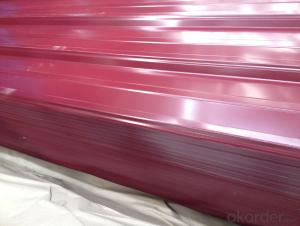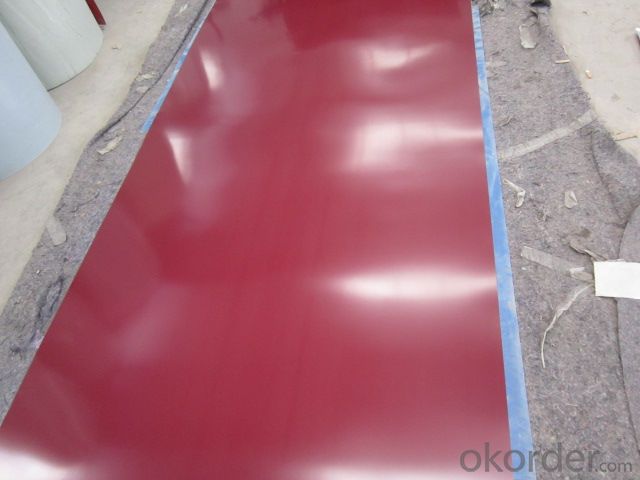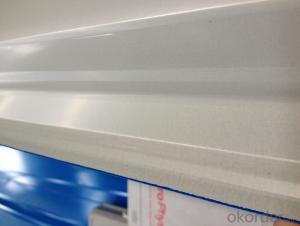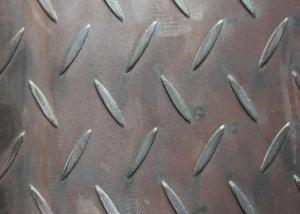Corrugated Pre-painted Galvanized Steel Sheet
- Loading Port:
- Tianjin
- Payment Terms:
- TT OR LC
- Min Order Qty:
- 25 m.t.
- Supply Capability:
- 1000 m.t./month
OKorder Service Pledge
OKorder Financial Service
You Might Also Like
Corrugated Pre-painted Galvanized Steel Sheet
Description:
Corrugated Pre Painted Steel Coil is coated with organic layer, which provides higher anti-corrosion property and a longer lifespan than that of galvanized steel sheets.
The base metals for Pre Painted Steel Coil consist of cold rolled, HDG electro-galvanized and hot-dip alu-zinc coated steel. The finish coats of Pre Painted Steel Coil can be classified into groups as follows: polyester, silicon modified polyesters, polyvinylidene fluoride, high-durability polyester, etc.
Pressing steel panel can be freely incised, it can satisfy the especially designing demands. It apply on convenient construction, and anti-seismic performance, fire proof, waterproof, free of maintenance, ect.
Base sheet : galvanized steel sheet, pre painted galvanized steel sheet
Application:
Since it adopts high strength steel sheet and the dimension is designed reasonably, the corrugated sheets are widely used on roofs and walls of various buildings, which can be easily installed, be flexible and changeable, unrestricted by no factor of the buildings.
Corrugated steel sheet is the colored steel plate which has been wave formed with the cold rolling treatment, trough especial coated dispose, the color coated steel panel’s guaranty is 12-15 years.
It has been widely applied on civil construction like storerooms, special building roof and walls of wide-span steel structure building and so on.
Product Specification:
Paint: PE or PVDF
Width and Thickness: width within 1250mm, thickness from 0.23-0.8
Color pre painted steel in coil
Zinc Coating: 50-180g/m2
Top coating:5 mic epoxy+20 mic pe, protection film
Back coating: 7 mic epoxy grey
Weight per coil:3-5 tons
Standard:JIS G3312,CGCC
Package:Standard seaworthy export packing: 3 layers of packing, inside is kraft paper,water plastic film is in the middle and outside GI steel ,sheet to be covered by steel strips with lock.
FAQ:
1.How many pieces for one package and the weight for one package?
The pieces for one tone is decided by the thickness of the sheet, but we can make it according to your requirements in the reasonable range.
Usually 2-3 tons for one package.
2. Could you provide special coulor for the sheet?
Yes, we can produce the goods according to the customer’s requirements.
3. Can you design the label according to our requirements?
Yes, we can. You just need to provide us the picture.
- Q: Can steel sheets be used for manufacturing shipping pallets?
- Yes, steel sheets can be used for manufacturing shipping pallets. Steel is a strong and durable material that can withstand heavy loads, making it suitable for the construction of pallets. Steel sheets can be welded or bolted together to create a sturdy and reliable pallet structure. Additionally, steel pallets have the advantage of being resistant to moisture, pests, and fire, which can be important considerations for certain industries or applications. However, it is worth noting that steel pallets are generally more expensive than other materials such as wood or plastic, so the choice of using steel sheets for manufacturing shipping pallets would depend on specific requirements, budget, and intended use.
- Q: What does "rolled steel" mean?.
- Rolling is a rolling process, the plate is kind of calendering material, not only some specific material, it can contain stainless steel and carbon steel materials, stainless steel with thickness of steel production for example, now the tolerance basic law, but in order to achieve a certain thickness
- Q: Can steel sheets be used for fencing?
- Yes, steel sheets can be used for fencing. They offer durability, strength, and security, making them an excellent choice for fencing applications.
- Q: What are the bending and forming capabilities of steel sheets?
- Steel sheets have excellent bending and forming capabilities due to their high tensile strength and ductility. They can be easily bent into various shapes without losing their structural integrity, making them suitable for applications requiring complex designs and precise specifications. Additionally, steel sheets can be formed through processes such as rolling, stamping, and deep drawing, allowing for the production of a wide range of products with different shapes and sizes.
- Q: Are steel sheets resistant to UV rays?
- Steel sheets do not possess inherent resistance to UV rays, contrary to belief. UV damage can indeed affect steel, leading to fading, discoloration, or even corrosion with the passage of time. However, the degree of harm incurred is contingent upon several factors, including the steel type, sheet thickness, UV exposure specifics, and presence of protective coatings. In order to bolster the UV resistance of steel sheets, manufacturers commonly administer coatings like paint, powder coatings, or galvanized finishes, which offer some level of defense against UV rays. It is vital to consult steel suppliers or manufacturers to ascertain the precise UV resistance capabilities of the steel sheets in use and consider supplementary protective measures if deemed necessary.
- Q: Can steel sheets be used for water treatment facilities?
- Yes, steel sheets can be used for water treatment facilities. Steel is a commonly used material in the construction of water treatment facilities due to its durability, strength, and resistance to corrosion. It is often employed in the fabrication of tanks, pipelines, and other infrastructure components used in water treatment processes.
- Q: What's the best way to open a 10mm thick steel sheet?
- Steel plate is a kind of flat steel with big width ratio and large surface area. According to the thickness of plate Ya divided into thick and thin plates two specifications.
- Q: How are steel sheets protected during welding?
- Shielding plays a crucial role in safeguarding steel sheets during welding. Its purpose is to shield the sheets from oxygen and other atmospheric contaminants that can lead to oxidation and impurities in the weld. Multiple methods are utilized to shield the steel sheets during welding. One commonly employed approach involves using a shielding gas, such as argon or carbon dioxide, which is directed towards the welding area to establish a protective atmosphere. This gas displaces the surrounding oxygen, effectively preventing it from reacting with the heated metal and causing oxidation. In addition to the use of shielding gas, another widely used method involves employing flux. Prior to welding, a substance known as flux is applied to the joint area of the steel sheets. Acting as a protective barrier, the flux creates a molten slag that covers the weld and provides shielding from the atmosphere. Flux can take the form of a powder, paste, or even a continuous wire feed during welding. Furthermore, certain welding techniques, like submerged arc welding, combine the use of both shielding gas and flux to offer optimal protection for the steel sheets. This technique involves the continuous feeding of granular flux along with the welding wire. As the flux melts, it forms a protective layer over the weld, while the shielding gas effectively prevents any atmospheric contamination. Overall, the safeguarding of steel sheets during welding is crucial for ensuring the weld's quality and integrity. Shielding methods, such as the use of shielding gas and flux, establish a protective environment that prevents the formation of oxidation, impurities, and other defects in the weld. Consequently, this results in a robust and long-lasting joint between the steel sheets.
- Q: Are steel sheets suitable for wastewater treatment facilities?
- Yes, steel sheets are suitable for wastewater treatment facilities. Steel sheets provide several advantages that make them a good choice for this application. Firstly, steel sheets are highly resistant to corrosion, which is crucial in wastewater treatment facilities where the presence of harsh chemicals and corrosive substances is common. This resistance to corrosion ensures the longevity and durability of the steel sheets, reducing maintenance and replacement costs. Additionally, steel sheets can withstand high temperatures and pressure, making them suitable for various processes involved in wastewater treatment, such as filtration and separation. Moreover, steel sheets are easy to clean and sanitize, which is essential in maintaining hygiene standards in wastewater treatment facilities. They can be easily washed and disinfected, preventing the growth of bacteria and other harmful microorganisms. Lastly, steel sheets are environmentally friendly as they can be recycled, reducing the environmental impact of wastewater treatment facilities. Overall, steel sheets offer the necessary strength, durability, and resistance to corrosion, making them a suitable choice for wastewater treatment facilities.
- Q: What are the advantages of using galvanized steel sheets?
- Using galvanized steel sheets in various applications offers several advantages. Firstly, they exhibit high resistance to corrosion. The process of galvanizing involves applying a zinc layer to the steel sheets, which acts as a protective barrier against rust and other forms of corrosion. This makes galvanized steel sheets ideal for outdoor applications or environments that are prone to moisture, like construction sites or coastal areas. Secondly, galvanized steel sheets possess excellent durability and longevity. The zinc coating enhances their overall strength and resistance to wear and tear. Consequently, galvanized steel sheets can withstand heavy loads, extreme temperatures, and other harsh conditions, making them suitable for long-term use. Moreover, galvanized steel sheets prove to be cost-effective. Though the initial cost may be slightly higher compared to other materials, their long lifespan and low maintenance requirements offset this investment. Galvanized steel sheets do not require frequent painting or sealing, saving both time and money in the long run. Furthermore, galvanized steel sheets are environmentally friendly. The zinc coating used in the galvanizing process is recyclable, contributing to sustainable practices. Additionally, the extended lifespan of galvanized steel sheets reduces the need for frequent replacements, minimizing waste and conserving resources. Lastly, galvanized steel sheets offer versatility in terms of applications. They can be easily formed, shaped, and cut to meet specific requirements, making them suitable for a wide range of industries, including construction, automotive, and manufacturing. The ability to customize galvanized steel sheets ensures their compatibility with various designs and structural needs. In conclusion, the benefits of using galvanized steel sheets encompass superior corrosion resistance, durability, cost-effectiveness, environmental friendliness, and versatility. These advantages make galvanized steel sheets a favored choice across numerous industries and applications.
Send your message to us
Corrugated Pre-painted Galvanized Steel Sheet
- Loading Port:
- Tianjin
- Payment Terms:
- TT OR LC
- Min Order Qty:
- 25 m.t.
- Supply Capability:
- 1000 m.t./month
OKorder Service Pledge
OKorder Financial Service
Similar products
Hot products
Hot Searches
Related keywords




























